
Cubism - II
Pablo Picasso
1881 – 1973

Pablo Picasso, 1904, Paris, photograph by Ricard Canals i Llambí
Pablo Ruiz Picasso
(25 October 1881 – 8 April 1973) was a Spanish painter, sculptor, printmaker, ceramicist and theatre designer who spent most of his adult life in France. One of the most influential artists of the 20th century, he is known for co-founding the Cubist movement, the invention of constructed sculpture, the co-invention of collage, and for the wide variety of styles that he helped develop and explore. Among his most famous works are the proto-Cubist Les Demoiselles d'Avignon (1907) and the anti-war painting Guernica (1937), a dramatic portrayal of the bombing of Guernica by German and Italian air forces during the Spanish Civil War.
Picasso demonstrated extraordinary artistic talent in his early years, painting in a naturalistic manner through his childhood and adolescence. During the first decade of the 20th century, his style changed as he experimented with different theories, techniques, and ideas. After 1906, the Fauvist work of the older artist Henri Matisse motivated Picasso to explore more radical styles, beginning a fruitful rivalry between the two artists, who subsequently were often paired by critics as the leaders of modern art.
Picasso's work is often categorized into periods. While the names of many of his later periods are debated, the most commonly accepted periods in his work are the Blue Period (1901–1904), the Rose Period (1904–1906), the African-influenced Period (1907–1909), Analytic Cubism (1909–1912), and Synthetic Cubism (1912–1919), also referred to as the Crystal period. Much of Picasso's work of the late 1910s and early 1920s is in a neoclassical style, and his work in the mid-1920s often has characteristics of Surrealism. His later work often combines elements of his earlier styles.
Exceptionally prolific throughout the course of his long life, Picasso achieved universal renown and immense fortune for his revolutionary artistic accomplishments, and became one of the best-known figures in 20th-century art.

Mother and son with handkerchief
Pablo Picasso
1903

Woman with raven
Pablo Picasso
1904

Pablo Picasso, The Tragedy, 1903

The Absinthe Drinker
Pablo Picasso
1901

The death of Casagemas
Pablo Picasso
1901
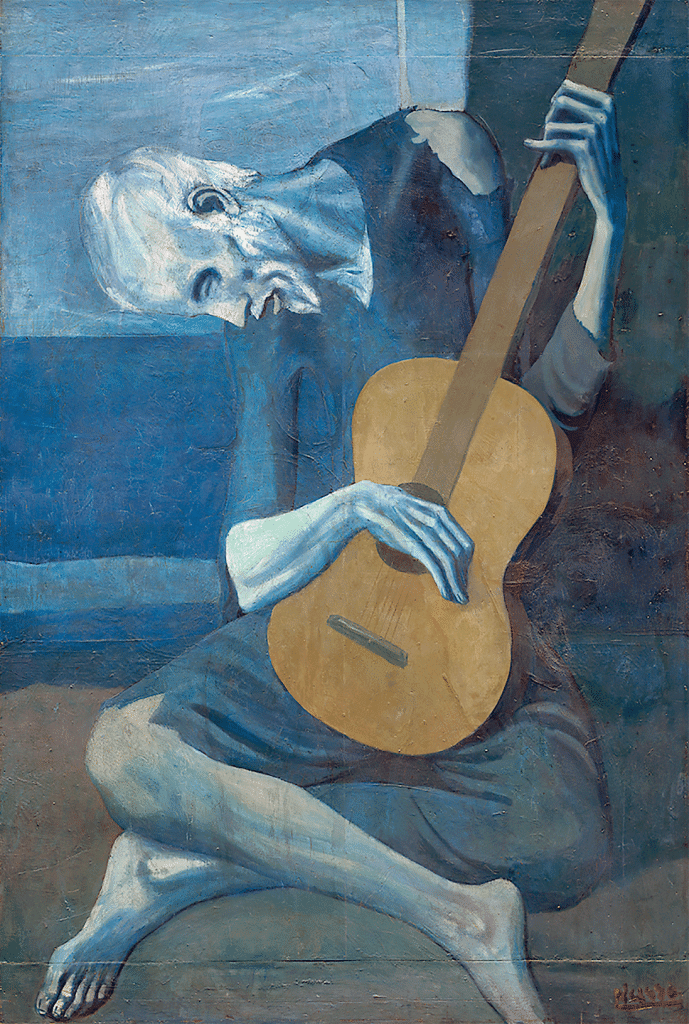
Pablo Picasso, 1903–04, The Old Guitarist

Pablo Picasso, 1904, Le repas frugal (The Frugal Repast)
Germaine Gargallo Pichot, Picasso's Lover

Germaine Gargallo Florentin Pichot went from being roommates with Pablo Picasso, to being lovers, and finally, friends. They spent 48 years together in all, from 1900-1948. She died in Paris in 1948.
Germaine Gargallo Florentin Pichot (1880 to 1948) entered Picasso's life in 1900 when the young artists from Barcelona arrived in Paris and stayed at Isidre Nonell's studio at 49 rue Gabriel. Germaine and her "sister" (Gertrude Stein claimed that Germaine had many "sisters") Antoinette Fornerod served as models and lovers. She was not related to Picasso's friend Pau Gargallo but did claim to be part Spanish. She spoke Spanish, as did Antoinette. Another young model, who called herself Odette (her real name was Louise Lenoir) hooked up with Picasso. Odette did not speak Spanish and Picasso did not speak French.
Germaine Gargallo Florentin Pichot

Two acrobats (Harlequin and his companion)
Pablo Picasso
1901

Life
Pablo Picasso
1903

The soup
Pablo Picasso
1903

Pablo Picasso, 1905, Garçon à la pipe, (Boy with a Pipe)
%2C_oil_on_canvas%2C_.jpg)
Pablo Picasso, 1905, Acrobate à la Boule (Acrobat on a Ball)
%2C_gouache_on_canvas%2C.jpg)
Pablo Picasso, 1904–05, Les Baladins (Mother and Child, Acrobats)

Pablo Picasso, 1905, Maternité (Mother and Child)
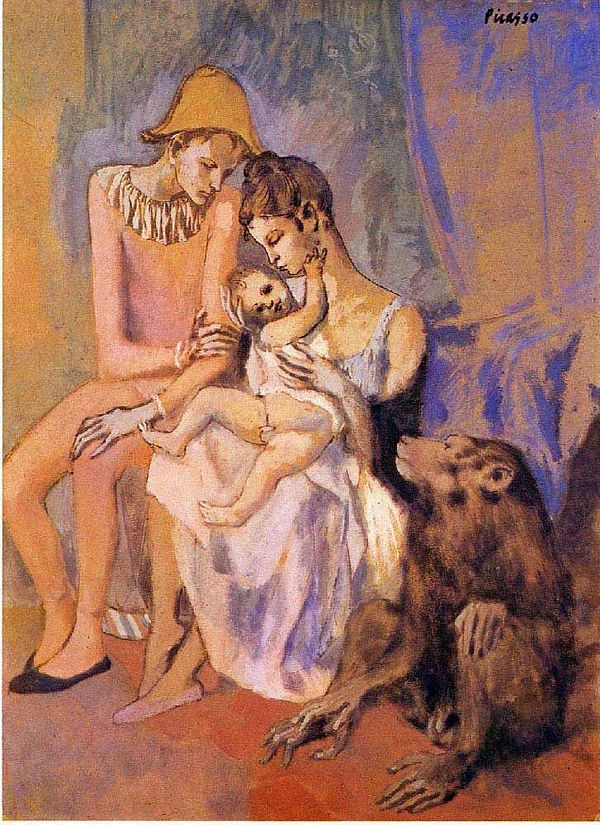
Pablo Picasso, 1905, Acrobat's Family with a Monkey (Famille au Singe)

Two friends
Pablo Picasso
1904

The girls of Avignon
Pablo Picasso
1907
Fernande Olivier, Muse and Mistress of Pablo Picasso

Fernande Olivier (born Amélie Lang; 6 June 1881 – 29 January 1966) was a French artist and model known primarily for having been the model and first muse of painter Pablo Picasso, and for her written accounts of her relationship with him. Picasso painted over 60 portraits of Olivier
She met Picasso at the Bateau-Lavoir, 13 Rue de Ravignan in 1904, and by the next year they were living together. Their relationship lasted seven years and was characterized by its tempestuousness. Both Olivier and Picasso were jealous lovers, and their passions sometimes exploded into violence. Picasso would often lock Olivier in their apartment when he went out due to his jealousy. Olivier wrote in her diary, "Picasso, due to a sort of morbid jealousy, kept me as a recluse. But with tea, books, a divan and little cleaning to do, I was happy, very happy."
Olivier was Picasso's first muse. In the spring and summer of 1906, following some sales of artwork, the couple were able to finance a trip to Barcelona and to the remote village of Gósol in the Spanish Pyrenees. In Barcelona Fernande was introduced to Picasso's family and local friends. In Gósol Picasso worked prolifically including executing several portraits of Fernande.] Later, among his most notable works of his Cubist period from 1907 to 1909, several were inspired by Olivier. These include Head of a Woman (Fernande). He later admitted that one of the Demoiselles d'Avignon was modeled after her.

Picasso with Fernande
1906

FERNANDE TO BLACK MANTILLA
Fernande à la mantille noir
1905

FERNANDE TO BLACK MANTILLA
Fernande à la mantille noir
1905

Pablo Picasso
The Three Dancers
1925

Women on the Banks of the Seine, after Courbet (1950)
By Pablo Picasso

Pablo Picasso, 1904, Le repas frugal (The Frugal Repast)
Eva Gouel, Muse and Mistress of Pablo Picasso

Eva Goeul (1885–December 14, 1915) was Pablo Picasso's lover during his Cubist collage period in the early 1910s, one of several influential and romantic partners in Picasso's life. She inspired a few of his most famous pieces of art, including "Woman with a Guitar," which is also known as "
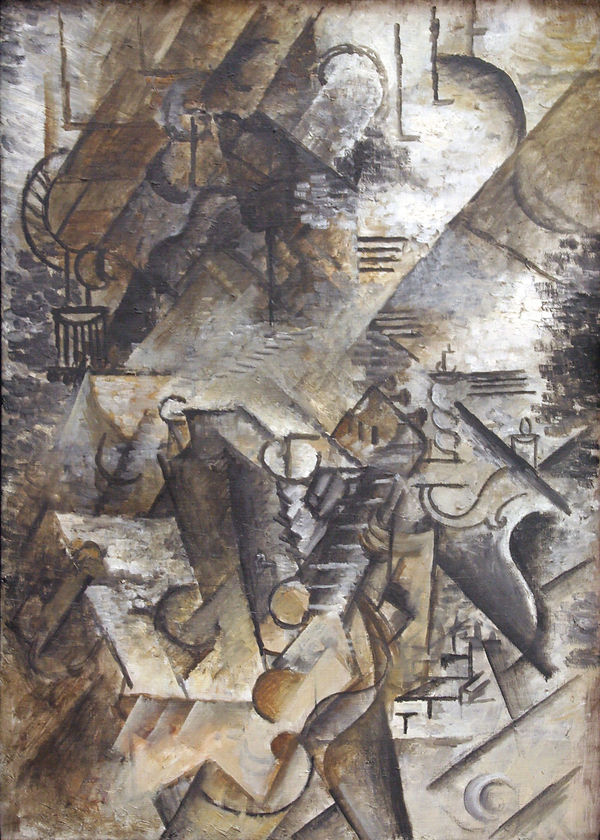
Pablo Picasso, 1911, Woman with a Guitar by the Piano
Pablo Picasso and Irène Lagut

French painter, Irène Lagut (1893-1999) was the companion of Serge Férat whom she met in 1913, and who was executed in November 1916 shortly after he, a poet was trepanned as a result of his injury.
"With him, she frequented the artists and writers associated with the Soirées de Paris. She was also the intimate friend of Jacqueline Kolb, future wife of Apollinaire. In 1916, she had an affair with Picasso whom she refused to marry.

Pablo Picasso, Lovers, 1923
Irène LAGUT, puis 1923

Three Musicians, 1921 by Pablo Picasso

Three Musicians, 1921 by Pablo Picasso

Three women at a fountain
Pablo Picasso
1921
Love Story in Paintings: Pablo Picasso and Olga Khoklova

Pablo Picasso and Olga Khoklova. 1917

Olga Khokhlova in Picasso's Montrouge studio, spring 1918
Olga Picasso
Olga Picasso (born Olga Stepanovna Khokhlova; 17 June 1891 – 11 February 1955) was a ballet dancer in the Russian ballet. She was also the first wife of Pablo Picasso, one of his early artistic muses and the mother of his son, Paulo.
Relationship with Picasso
In 1917, Pablo Picasso became involved in Parade, a ballet by Sergei Diaghilev, Erik Satie and Jean Cocteau. The ballet premiered on 18 May 1917 at the Théâtre du Châtelet in Paris. Picasso had designed the costumes and set for the ballet. After seeing Khokhlova dance in rehearsals for a ballet named Les Femmes de Bonne Humeur in Italy, he fell in love with her.
Khokhlova married Picasso on 12 July 1918, at the Russian Orthodox Cathedral at the Rue Daru in Paris. Jean Cocteau and Max Jacob were witnesses to the marriage. The wedding had been postponed from May 1918, due to Khokhlova experiencing pain from a foot injury. The injury forced her to undergo an operation that resulted in having to wear plaster encasing her right leg. It was only when the leg had healed that the marriage could take place. After the wedding, the Picassos spent their honeymoon at the villa of Eugenia Errázuriz in Biarritz, where Picasso made drawings of his wife. By September 1918, Khokhlova had recovered from her injury, but required rehabilitation. She never danced again in public. By October 1918, the couple returned to Paris in search of an apartment. Picasso's dealer, Paul Rosenberg, found a suitable apartment next to his own home, at 23, Rue La Boétie, into which the Picassos moved the week before Christmas 1918.
On 4 February 1921, Khokhlova gave birth to a boy named Paulo.[6] From then on, Khokhlova and Picasso's relationship deteriorated. Picasso was proud of Khokhlova and his son, but she became obsessively protective of the boy. She enjoyed the prestige of being Picasso's wife and the idea of a celebrity lifestyle.
In 1927, Picasso began an affair with a 17-year-old French girl, Marie-Thérèse Walter. He continued to play the part of the conventional husband and father but continued his affair with his new mistress in secret. In the summer of 1928, the Picasso family spent time in Dinard, where Picasso also secreted his mistress away from his wife. At Picasso's first major retrospective at the Galeries Georges Petit in 1932, he blatantly displayed numerous works of his mistress.
In 1935, Khokhlova learned of the affair from a friend, who also informed her that Walter was pregnant. She was devastated, filed for divorce, and immediately moved to the Hôtel California with Paulo. She spent the next 20 years living in Parisian hotels, Boisgeloup and the South of France. Picasso refused to divide his property evenly with her, as required by French law, so Khokhlova stayed legally married to him until her death from cancer in Cannes, France, on 11 February 1955.

Olga Khokhlova in Mantilla
Pablo Picasso 1917

Olga Khokhlova, Pablo Picasso, 1917
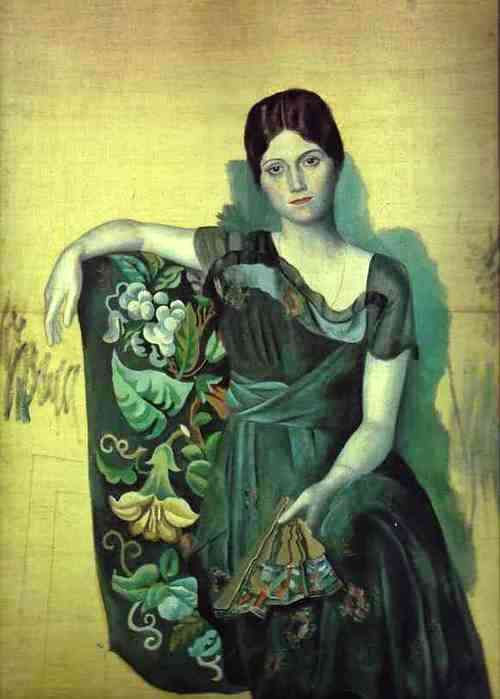
1918 Portrait of Khokhlova in an armchair. 1918
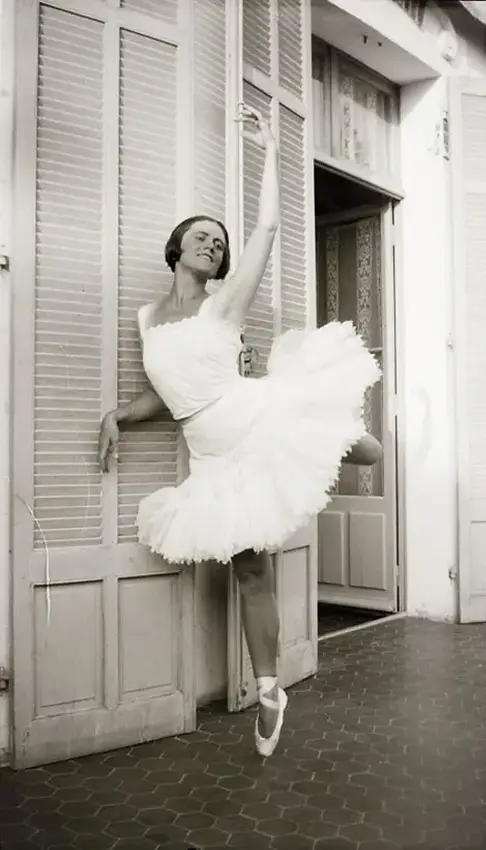
Olga at Juan-Les-Pins, 1925.

A group of dancers
Pablo Picasso
1920

Portrait Of Olga Khokhlova
Pablo Picasso
1918

Mother and child
Pablo Picasso
1922

Family at sea
Pablo Picasso
1922

Pablo Picasso. Olga Picasso
1923

Pablo Picasso. Olga Picasso
1923
Love Story in Paintings: Pablo Picasso and Marie-Thérèse Walter
Marie-Thérèse Walter (13 July 1909 – 20 October 1977) was a French model and lover of Pablo Picasso from 1927 to about 1935 and the mother of their daughter Maya Widmaier-Picasso. Their relationship began when she was seventeen years old; he was 45 and married to his first wife, Olga Khokhlova. It ended after Picasso moved on to his next relationship, with artist Dora Maar. Walter is known as Picasso's "golden muse" and inspired numerous artworks and sculptures that he created of her during their relationship.

Marie-Thérèse Walter

Portrait of Marie-Thérèse Walter
Pablo Picasso

Portrait of Marie-Thérèse Walter
Pablo Picasso

Portrait of Marie-Thérèse Walter
Pablo Picasso

Portrait of Marie-Thérèse Walter
Pablo Picasso

Portrait of Marie-Thérèse Walter
Pablo Picasso
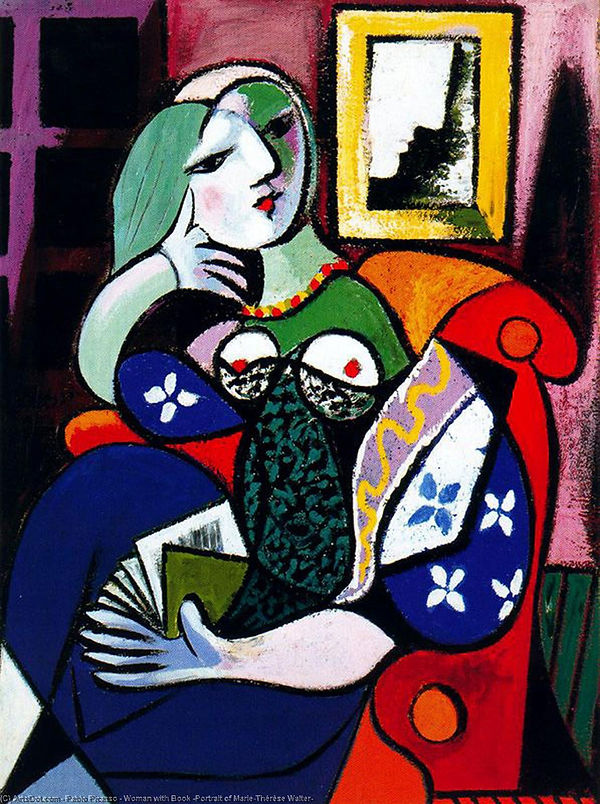
WOMAN WITH BOOK (PORTRAIT OF MARIE-THÉRÈSE WALTER)
Pablo Picasso

Portrait of Marie-Thérèse Walter with garland
Pablo Picasso
1937

Seated Portrait of Marie-Therese Walter
Pablo Picasso
1937

PABLO PICASSO: GUERNICA. 1937. Madrid. Prado

PABLO PICASSO: GUERNICA. 1937. Madrid. Prado

PABLO PICASSO: GUERNICA. 1937. Madrid. Prado

PABLO PICASSO: GUERNICA. 1937. Madrid. Prado
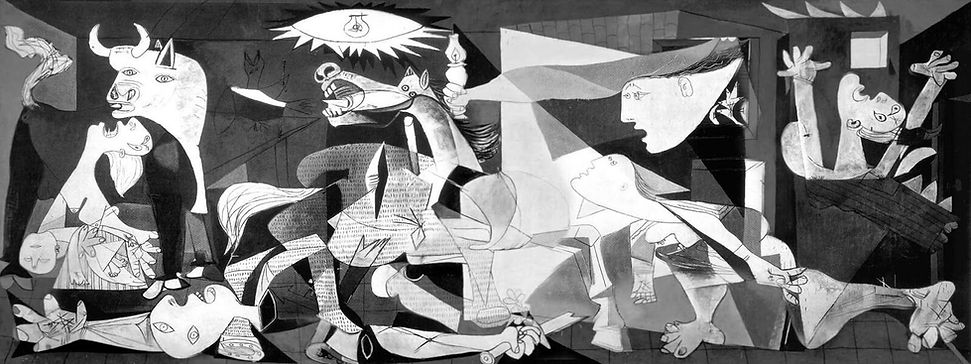
PABLO PICASSO: GUERNICA. 1937. Madrid. Prado
Love Story in Paintings: Pablo Picasso and Dora Maar

Dora Maar photographed by Man Ray in 1936
Henriette Theodora Markovitch (22 November 1907 – 16 July 1997), known as Dora Maar, was a French photographer, painter, and poet. A romantic partner of Pablo Picasso, Maar was depicted in a number of Picasso's paintings, including his Portrait of Dora Maar and Dora Maar au Chat.
The Weeping Woman (French: La Femme qui pleure) is a series of oil on canvas paintings by Pablo Picasso, the last of which was created in late 1937. The paintings depict Dora Maar, Picasso's mistress and muse. The Weeping Woman paintings were produced by Picasso in response to the bombing of Guernica in the Spanish Civil War and are closely associated with the iconography in his painting Guernica. Picasso was intrigued with the subject of the weeping woman, and revisited the theme numerous times that year. The last version, created on 26 October 1937, was the most elaborate of the series, and has been housed in the collection of the Tate Modern in London since 1987. Another Weeping Woman painting is housed at the National Gallery of Victoria and was involved in a high-profile political art theft.

PABLO PICASSO: The Weeping Woman
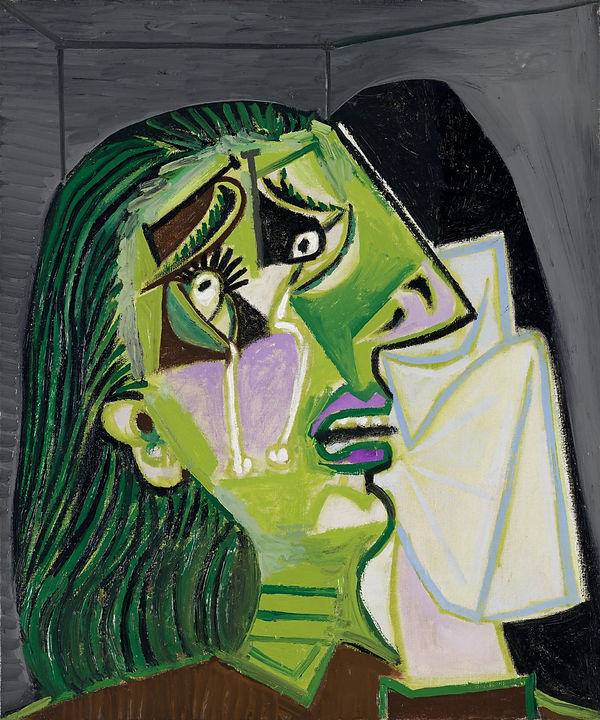
Weeping woman
(1937)
Pablo PICASSO

PABLO PICASSO: WEEPING WOMAN
La femme qui pleure
1937

PABLO PICASSO: WEEPING WOMAN
La femme qui pleure
1937

PABLO PICASSO: THE SUPPLIANT
La suppliante
1937

PABLO PICASSO: Weeping woman with handkerchief
1937

PABLO PICASSO: WEEPING WOMAN
La femme qui pleure
1937

The yellow shirt (Dora Maar)
Pablo Picasso
1939

Dora Maar
Pablo Picasso

Portrait of Dora Maar
Pablo Picasso

Portrait of Dora Maar
Pablo Picasso
Pablo Picasso's Love: Françoise Gilot
Françoise Gilot (born 1921) was an art student when she met Picasso met in a cafe in 1943—he was 62, she was 22. While he was still married to Olga Khokhlova, Gilot and Picasso had an intellectual attraction that led to romance. They kept their relationship a secret at first, but Gilot moved in with Picasso after a few years and they had two children, Claude and Paloma.
Françoise grew tired of his abuse and affairs and left him in 1953. Eleven years later, she wrote a book about her life with Picasso. In 1970, she married American physician and medical researcher, Jonas Salk, who created and developed the first successful vaccine against polio.

Françoise Gilot and Picasso in 1948

Picasso Portrait of Francoise Gilot

Picasso Portrait of Francoise Gilot
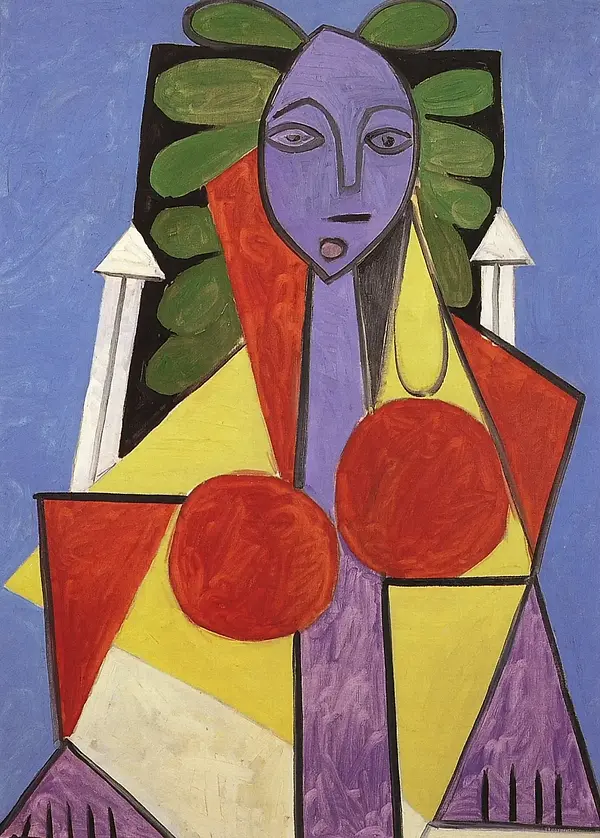
Picasso Portrait of Francoise Gilot

Picasso Portrait of Francoise Gilot
Jacqueline Roque: Picasso’s Final Muse
Jacqueline Roque
Picasso met Jacqueline Roque (1927–1986) in 1953 at the Madoura Pottery where he created his ceramics. Following her divorce, she became his second wife in 1961, when Picasso was 79 and she was 34. Picasso was greatly inspired by Roque, creating more works based on her than on any of the other women in his life—in one year he painted more than 70 portraits of her. Jacqueline was the only woman he painted for the last 17 years of his life.
When Picasso died on April 8, 1973, Jacqueline prevented his children, Paloma and Claude, from attending the funeral because Picasso had disinherited them after their mother, Françoise, had published her book, Life with Picasso. In 1986, Roque committed suicide by shooting herself in the castle on the French Riviera where she had lived with Picasso until his death.

Jacqueline Roque with Pablo Picasso

Portrait of Jacqueline Roque
Pablo Picasso
1956

Portrait of Jacqueline Roque
Pablo Picasso
1954

Portrait of Jacqueline Roque
Pablo Picasso
1954

Portrait of Jacqueline Roque
Pablo Picasso
1971

Portrait of Jacqueline Roque
Pablo Picasso
Georges Braque
1882 – 1963
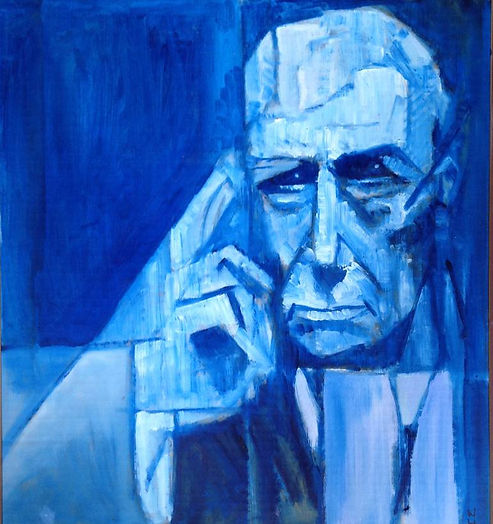
Portrait of Georges Braque Painting by William Wright
Georges Braque
(13 May 1882 – 31 August 1963) was a major 20th-century French painter, collagist, draughtsman, printmaker and sculptor. His most notable contributions were in his alliance with Fauvism from 1905, and the role he played in the development of Cubism. Braque's work between 1908 and 1912 is closely associated with that of his colleague Pablo Picasso. Their respective Cubist works were indistinguishable for many years, yet the quiet nature of Braque was partially eclipsed by the fame and notoriety of Picasso.
Fauvism
Braque's earliest works were impressionistic, but after seeing the work exhibited by the artistic group known as the "Fauves" (Beasts) in 1905, he adopted a Fauvist style. The Fauves, a group that included Henri Matisse and André Derain among others, used brilliant colors to represent emotional response. Braque worked most closely with the artists Raoul Dufy and Othon Friesz, who shared Braque's hometown of Le Havre, to develop a somewhat more subdued Fauvist style. In 1906, Braque traveled with Friesz to L'Estaque, to Antwerp, and home to Le Havre to paint.
In May 1907, he successfully exhibited works of the Fauve style in the Salon des Indépendants. The same year, Braque's style began a slow evolution as he became influenced by Paul Cézanne who had died in 1906 and whose works were exhibited in Paris for the first time in a large-scale, museum-like retrospective in September 1907. The 1907 Cézanne retrospective at the Salon d'Automne greatly affected the avant-garde artists of Paris, resulting in the advent of Cubism.
Cubism
Braque's paintings of 1908–1912 reflected his new interest in geometry and simultaneous perspective. He conducted an intense study of the effects of light and perspective and the technical means that painters use to represent these effects, seeming to question the most standard of artistic conventions. In his village scenes, for example, Braque frequently reduced an architectural structure to a geometric form approximating a cube, yet rendered its shading so that it looked both flat and three-dimensional by fragmenting the image. He showed this in the painting Houses at l'Estaque.
Beginning in 1909, Braque began to work closely with Pablo Picasso who had been developing a similar proto-Cubist style of painting. At the time, Pablo Picasso was influenced by Gauguin, Cézanne, African masks and Iberian sculpture while Braque was interested mainly in developing Cézanne's ideas of multiple perspectives. “A comparison of the works of Picasso and Braque during 1908 reveals that the effect of his encounter with Picasso was more to accelerate and intensify Braque’s exploration of Cézanne’s ideas, rather than to divert his thinking in any essential way.” Braque's essential subject is the ordinary objects he has known practically forever. Picasso celebrates animation, while Braque celebrates contemplation. Thus, the invention of Cubism was a joint effort between Picasso and Braque, then residents of Montmartre, Paris. These artists were the style's main innovators. After meeting in October or November 1907, Braque and Picasso, in particular, began working on the development of Cubism in 1908. Both artists produced paintings of monochromatic color and complex patterns of faceted form, now termed Analytic Cubism.
Braque's paintings of 1908–1912 reflected his new interest in geometry and simultaneous perspective. He conducted an intense study of the effects of light and perspective and the technical means that painters use to represent these effects, seeming to question the most standard of artistic conventions. In his village scenes, for example, Braque frequently reduced an architectural structure to a geometric form approximating a cube, yet rendered its shading so that it looked both flat and three-dimensional by fragmenting the image. He showed this in the painting Houses at l'Estaque.
Beginning in 1909, Braque began to work closely with Pablo Picasso who had been developing a similar proto-Cubist style of painting. At the time, Pablo Picasso was influenced by Gauguin, Cézanne, African masks and Iberian sculpture while Braque was interested mainly in developing Cézanne's ideas of multiple perspectives. “A comparison of the works of Picasso and Braque during 1908 reveals that the effect of his encounter with Picasso was more to accelerate and intensify Braque’s exploration of Cézanne’s ideas, rather than to divert his thinking in any essential way.” Braque's essential subject is the ordinary objects he has known practically forever. Picasso celebrates animation, while Braque celebrates contemplation. Thus, the invention of Cubism was a joint effort between Picasso and Braque, then residents of Montmartre, Paris. These artists were the style's main innovators. After meeting in October or November 1907, Braque and Picasso, in particular, began working on the development of Cubism in 1908. Both artists produced paintings of monochromatic color and complex patterns of faceted form, now termed Analytic Cubism.
A decisive time of its development occurred during the summer of 1911, when Georges Braque and Pablo Picasso painted side by side in Céret in the French Pyrenees, each artist producing paintings that are difficult—sometimes virtually impossible—to distinguish from those of the other. In 1912, they began to experiment with collage and Braque invented the papier collé technique
On 14 November 1908, the French art critic Louis Vauxcelles, in his review of Georges Braque's exhibition at Kahnweiler's gallery called Braque a daring man who despises form, "reducing everything, places and a figures and houses, to geometric schemas, to cubes".
Vauxcelles, on 25 March 1909, used the terms "bizarreries cubiques" (cubic oddities) after seeing a painting by Braque at the Salon des Indépendants.
The term 'Cubism', first pronounced in 1911 with reference to artists exhibiting at the Salon des Indépendants, quickly gained wide use but Picasso and Braque did not adopt it initially. Art historian Ernst Gombrich described Cubism as "the most radical attempt to stamp out ambiguity and to enforce one reading of the picture—that of a man-made construction, a colored canvas." The Cubist style spread quickly throughout Paris and then Europe.
The two artists' productive collaboration continued and they worked closely together until the beginning of World War I in 1914, when Braque enlisted with the French Army. In May 1915, Braque received a severe head injury in battle at Carency and suffered temporary blindness. He was trepanned, and required a long period of recuperation.

Georges Braque, 1906, L'Olivier près de l'Estaque (The Olive tree near l'Estaque). At least four versions of this scene were painted by Braque, one of which was stolen from the Musée d'Art

Georges Braque, 1907–08, The Viaduct at L'Estaque (Le Viaduc de l'Estaque)

Georges Braque, 1908, Maisons et arbre (Houses at l'Estaque)

Georges Braque, 1908, Baigneuse (Le Grand Nu, Large Nude)

Georges Braque, late 1909, Still Life with Metronome (Still Life with Mandola and Metronome)

Georges Braque, 1910, Violin and Candlestick

Georges Braque, 1908, Plate and Fruit Dish

Georges Braque, 1908, Maisons à l'Estaque (Houses at l'Estaque)
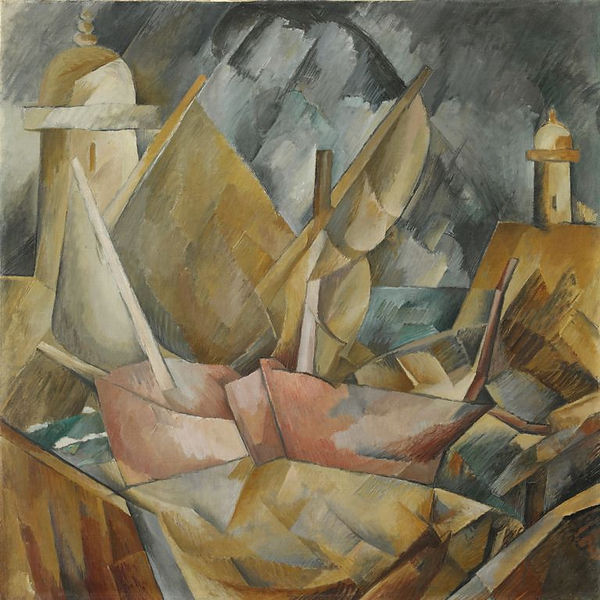
Georges Braque, 1909, Port en Normandie (Little Harbor in Normandy)

Georges Braque, 1909–10, Pitcher and Violin

Georges Braque, 1910, Femme tenant une Mandoline

Georges Braque, 1910, Portrait of a Woman, Female Figure (Torso Ženy)

Georges Braque, 1911, Nature Morte (The Pedestal Table)
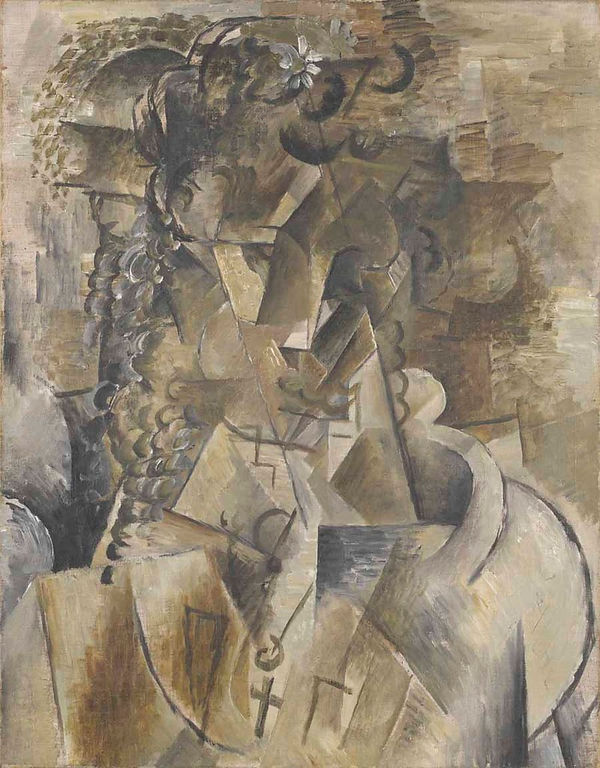
Georges Braque, 1911–12, Girl with a Cross

Georges Braque, 1911–12, Man with a Guitar (Figure, L'homme à la guitare)

Georges Braque, 1912, Violin: "Mozart Kubelick"

Georges Braque, 1913, Nature morte (Fruit Dish, Ace of Clubs)

Georges Braque, 1913, Femme à la guitare (Woman with Guitar)

Georges Braque, 1913–14, Still Life on a Table (Duo pour Flute)

The Birds
Georges Braque
1953

The Echo
Georges Braque
c.1954;

A winging
Georges Braque
1955

Bird and it's nest
Georges Braque
c.1958

Blue Aquarium
Georges Braque
1962
Jean Metzinger
1883 – 1956
Jean Dominique Antony Metzinger (24 June 1883 – 3 November 1956) was a major 20th-century French painter, theorist, writer, critic and poet, who along with Albert Gleizes wrote the first theoretical work on Cubism. His earliest works, from 1900 to 1904, were influenced by the neo-Impressionism of Georges Seurat and Henri-Edmond Cross. Between 1904 and 1907 Metzinger worked in the Divisionist and Fauvist styles with a strong Cézannian component, leading to some of the first proto-Cubist works.
From 1908 Metzinger experimented with the faceting of form, a style that would soon become known as Cubism. His early involvement in Cubism saw him both as an influential artist and an important theorist of the movement. The idea of moving around an object in order to see it from different view-points is treated, for the first time, in Metzinger's Note sur la Peinture, published in 1910.[5] Before the emergence of Cubism, painters worked from the limiting factor of a single view-point. Metzinger, for the first time, in Note sur la peinture, enunciated the interest in representing objects as remembered from successive and subjective experiences within the context of both space and time. Jean Metzinger and Albert Gleizes wrote the first major treatise on Cubism in 1912, entitled Du "Cubisme". Metzinger was a founding member of the Section d'Or group of artists.
Metzinger was at the center of Cubism both because of his participation and identification of the movement when it first emerged, because of his role as intermediary among the Bateau-Lavoir group and the Section d'Or Cubists, and above all because of his artistic personality.[6] During the First World War Metzinger furthered his role as a leading Cubist with his co-founding of the second phase of the movement, referred to as Crystal Cubism. He recognized the importance of mathematics in art, through a radical geometrization of form as an underlying architectural basis for his wartime compositions. The establishing of the basis of this new perspective, and the principles upon which an essentially non-representational art could be built, led to La Peinture et ses lois (Painting and its Laws), written by Albert Gleizes in 1922–23. As post-war reconstruction began, a series of exhibitions at Léonce Rosenberg's Galerie de L'Effort Moderne were to highlight order and allegiance to the aesthetically pure. The collective phenomenon of Cubism—now in its advanced revisionist form—became part of a widely discussed development in French culture, with Metzinger at its helm. Crystal Cubism was the culmination of a continuous narrowing of scope in the name of a return to order; based upon the observation of the artist's relation to nature, rather than on the nature of reality itself. In terms of the separation of culture and life, this period emerges as the most important in the history of Modernism.

Jean Metzinger

Jean Metzinger, 1912, Danseuse au café (Dancer in a café)

Jean Metzinger,
c.1905, Baigneuses, Deux nus dans un jardin exotique (Two Nudes in an Exotic Landscape)

Jean Metzinger, ca. 1906, Coucher de Soleil No. 1 (Landscape)

Jean Metzinger, 1907, Paysage coloré aux oiseaux aquatiques

Jean Metzinger, 1910–11, Deux Nus (Two Nudes, Two Women)

Jean Metzinger, 1910–11, Deux Nus (Two Nudes, Two Women)

Jean Metzinger, 1912, Femme à l'Éventail (Woman with a Fan)

Jean Metzinger, 1912–1913, L'Oiseau bleu, (The Blue Bird)

Jean Metzinger, 1913, La Femme à l'Éventail (Woman with a Fan)

Jean Metzinger, c.1906, Femme au Chapeau (Woman with a Hat)
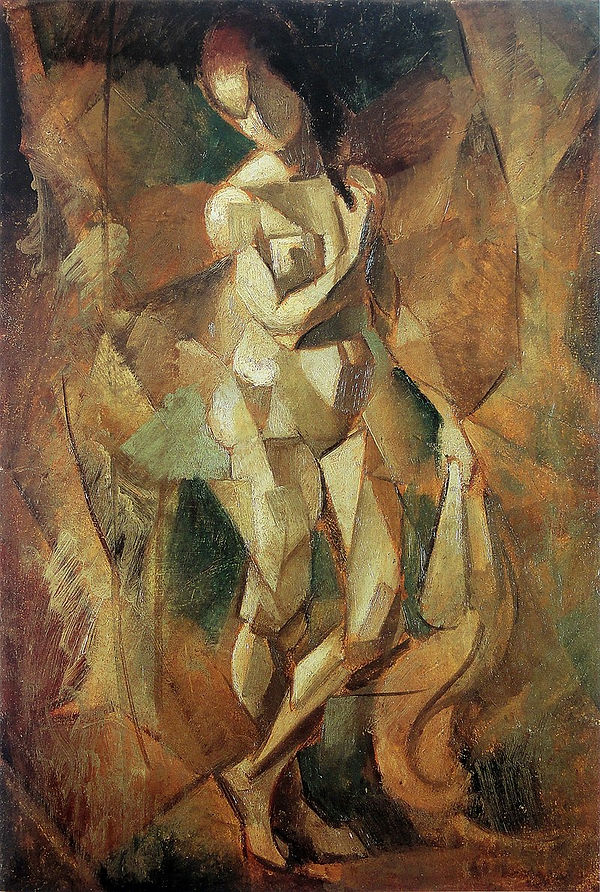
Jean Metzinger, 1910–11, Nu (Nu debout)

Jean Metzinger, 1912, At the Cycle-Race Track (Au Vélodrome)
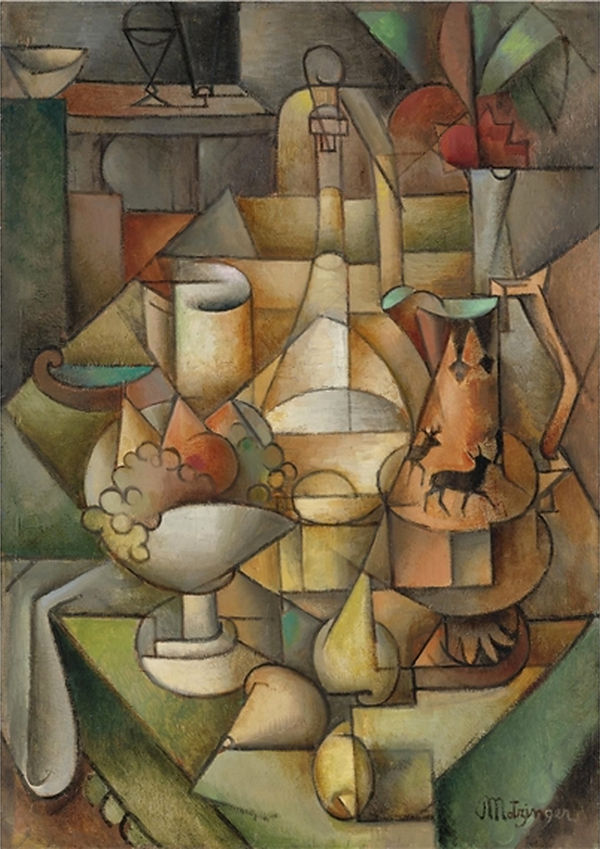
Jean Metzinger, c.1911, Nature morte (Compotier et cruche décorée de cerfs)

Femme assise, en robe bleue
Jean Metzinger
1950

Nu Couché (Reclining Figure)
Jean Metzinger
1946

Nu au Soleil (Nude in the Sun)
Jean Metzinger
1935

Nu aux Hortensias
Jean Metzinger
1935

La Baigneuse, (Nu)
Jean Metzinger
1937

Yachting
Jean Metzinger
1937

Femme Debout
Jean Metzinger

La Violoniste
Jean Metzinger
1955
Mariya Vassilieva
1884 – 1957
Mariya Ivanovna Vassiliéva (12 February 1884 – 14 May 1957), better known as Marie Vassilieff, was a Russian-born painter active in Paris.
She moved to Paris at the age of twenty-three and became an integral part of the artistic community on its left bank called, Montparnasse.
She was born in Smolensk, Russia to a prosperous family who encouraged her to study medicine. Her natural instincts, however, were for the arts and, in 1903 she switched to the study of art at the Academy in St. Petersburg. 1905 she visited the artistic capital of the world, Paris, France.
Two years later, she moved to Paris, taking a job as a correspondent for several Russian newspapers while studying painting under Henri Matisse and attending classes at the École nationale supérieure des Beaux-Arts.
In 1908 she founded the Académie Russe (Russian Academy), which was renamed the following year as, the Académie Vassilieff.
In 1912 she opened her own atelier in Montparnasse. It became the nexus for those at the cutting-edge of art at the time, when Erik Satie, Henri Matisse, Nina Hamnett, Amedeo Modigliani, Ossip Zadkine, Olga Sacharoff, Juan Gris, and Chaïm Soutine started dropping by in the evenings for conversation and occasionally to draw.
Before long the walls of Marie Vassilieff's atelier held a collection of paintings by Marc Chagall and Modigliani, drawings by Picasso and Fernand Léger, and in a corner, sat a sculpture by Zadkine.
By 1913, her studio was so widely known that Fernand Léger gave two lectures there on the topic of Modern art.
What Marie Vassilieff is most remembered for, however, is her canteen that operated before and during World War I. She volunteered as a nurse in the French Red Cross and saw how badly the financial situation had become for many of the artists of Paris who were already struggling. Because many of her artist acquaintances frequently had little or nothing to eat, in 1915, she opened the canteen that provided a full meal and a glass of wine for only a few centimes.
While her canteen provided a valuable service, during the war it became a popular gathering place for the artistic community. During the war a government curfew was put into place. The restaurants and cafés of Paris all were obliged to close early, however, Marie Vassilieff's canteen was licensed as a private club and, therefore, not subject to the curfew. As a result, soon her place became crowded and at night, filled with music and dancing.
In January 1917, Georges Braque, who had been wounded fighting in World War I, was released from military service. Marie Vassilieff and Max Jacob decided to organize a dinner for Braque and his wife, Marcelle. Among the guests was Alfredo Pina with his new companion, Beatrice Hastings, who had recently ended her two-year relationship with Amedeo Modigliani. Knowing Modigliani's penchant for causing a disturbance when he drank, and that he drank often, Marie Vassilieff did not invite Modigliani to Braque's party. The art community was small, however, and word of the get-together soon reached Modigliani. An uninvited, and very drunk, Modigliani showed up, looking for a fight. A scuffle ensued, a pistol appeared, and Marie Vassilieff, all five feet of her, pushed Modigliani downstairs while Pablo Picasso and Manuel Ortiz de Zarate locked the door. Marie Vassilieff made what is now a very famous drawing depicting the events of the evening.
Marie Vassilieff's own artwork is primarily in the Cubist style, her most interesting paintings are portraits of dancers as well as those of her friends, Jean Cocteau, Picasso, and Matisse. Known, too, for her decorative furniture pieces and her doll-portraits, Vassilieff's works remain very popular. Although her works never gained the lofty stature or astounding prices of some of her renowned contemporaries, today they may be found in museums and private collections worldwide.
As both an artist and friend, Marie Vassilieff was an integral part of the great creative community of Montparnasse, where today one may still see her ornamental panels, created in 1927 for the pillars in the dining room of the La Coupole.
After several exhibitions in London in 1928 and 1930, and in Italy in 1929, she opened the Vassilieff Museum. Friends with Alfred Jarry, she organized a homage to him.
Marie Vassilieff died at a home for elderly artists in Nogent-sur-Marne, Île-de-France, France, on 14 May 1957.
.jpg)
Mariya Vassiliéva
.jpg)
Mariya Vassiliéva
.jpg)
Mariya Vassiliéva
.jpg)
Mariya Vassiliéva
.jpg)
Mariya Vassiliéva
.jpg)
Mariya Vassiliéva
.jpg)
Mariya Vassiliéva
.jpg)
Mariya Vassiliéva
.jpg)
Mariya Vassiliéva
.jpg)
Mariya Vassiliéva
.jpg)
Mariya Vassiliéva
.jpg)
Mariya Vassiliéva
.jpg)
Mariya Vassiliéva
.jpg)
Mariya Vassiliéva
.jpg)
Mariya Vassiliéva
.jpg)
Mariya Vassiliéva
.jpg)
Mariya Vassiliéva
.jpg)
Mariya Vassiliéva
.jpg)
Mariya Vassiliéva
Roger de La Fresnaye
1885 – 1925

ROGER DE LA FRESNAYE: SITTING MAN OR THE ARCHITECT. 1914. Paris. MNAM

Roger de La Fresnaye
(11 July 1885 – 27 November 1925) was a French Cubist painter.
La Fresnaye was born in Le Mans where his father, an officer in the French army, was temporarily stationed. The La Fresnayes were an aristocratic family whose ancestral home, the Château de La Fresnaye, is in Falaise. His education was classically based, and was followed from 1903 to 1904 by studies at the Académie Julian in Paris, and from 1904 to 1908 at the École des Beaux-Arts. From 1908 he studied at the Académie Ranson under Maurice Denis and Paul Sérusier, whose joint influence is evident in early works such as Woman with Chrysanthemums, 1909. This demonstrates the dreamlike symbolist ambience and stylistic character of work by the Les Nabis group. In 1909, Fresnaye travelled to Munich, where he encountered the German Expressionists, and then, in 1911, to northern Italy where he began to introduce more cuboid and abstract elements into his own painting.

The Bathers (Les Baigneuses), 1912

The Conquest of the Air, 1913

La table Louis-Philippe, 1922

La Vie Conjugal (Married Life) 1913

The Fourteenth of July

The Factory Chimney, Meulan Landscape
Andre Lhote
1885 -1962

Andre Lhote
(b Bordeaux, 5 July 1885; d Paris, 25 Jan 1962).
French painter, critic and teacher. From the age of 12 he was apprenticed by his father to a maker of wood-carvings. He followed the course in decorative arts at the Ecole des Beaux-Arts in Bordeaux and did not definitively abandon ornamental sculpture for painting until 1905. Perhaps as a consequence, Lhote was one of the few 20th-century artists and theoreticians who not only accepted the term ‘decorative’ in connection with art but also exalted it, finding in mural painting the highest public realization of his ambitions. Like Albert Gleizes and Fernand Léger, he welcomed the limitations of wall painting because its conditions insisted on flatness as integral to a large plane surface.

L'Escale

French Landscape, 1912

14 July, Port de Bordeaux-Poincaré, 1913–14

Hommage a Watteau - Arlequin Damasque

Figure en Bleu
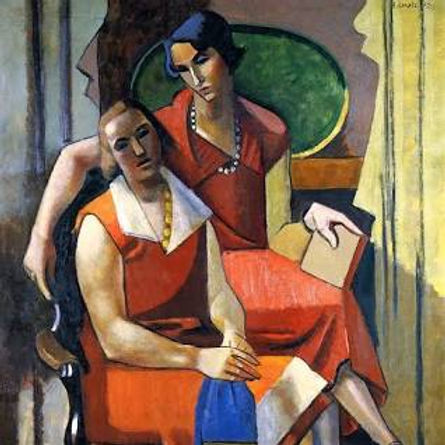
Les deux amies
1925

Nu Cubiste

La baigneuse assise

Nu

Nu blond

Nu

Nu
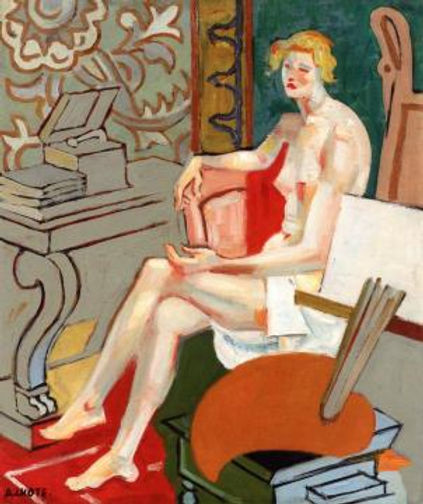
Nu

Portrait of Marguerite 1915
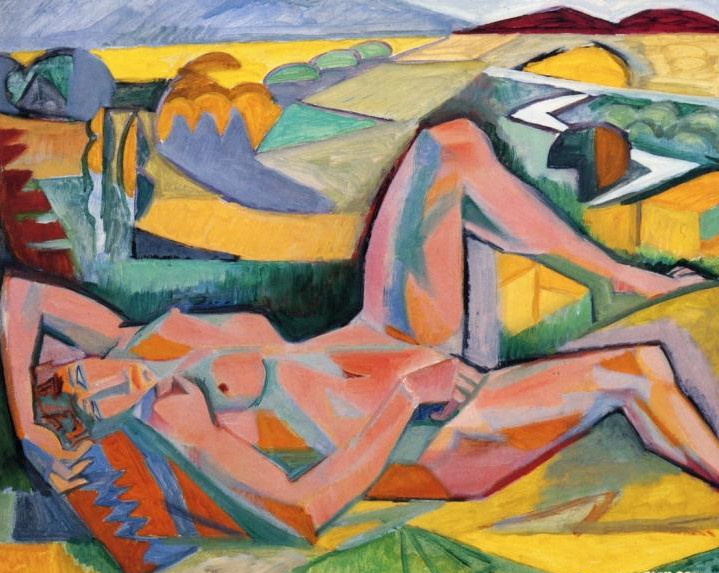
Reclining Female Nude

Bathers

Bacchante

Nu assis -1917

Tete sur fond Rouge et Vert

La danse au bar
Juan Gris
1887 – 1927

Juan Gris
(23 March 1887 – 11 May 1927), better known as Juan Gris, was a Spanish painter born in Madrid who lived and worked in France for most of his active period. Closely connected to the innovative artistic genre Cubism, his works are among the movement's most distinctive.
Gris was born in Madrid and later studied engineering at the Madrid School of Arts and Sciences. There, from 1902 to 1904, he contributed drawings to local periodicals. From 1904 to 1905, he studied painting with the academic artist José Moreno Carbonero. It was in 1905 that José Victoriano González adopted the more distinctive name Juan Gris.
In 1909, Lucie Belin (1891–1942)—Gris' wife—gave birth to Georges Gonzalez-Gris (1909–2003), the artist's only child. The three lived at the Bateau-Lavoir, 13 Rue Ravignan, Paris, from 1909 to 1911. In 1912 Gris met Charlotte Augusta Fernande Herpin (1894–1983), also known as Josette. Late 1913 or early 1914 they lived together at the Bateau-Lavoir until 1922. Josette Gris was Juan Gris' second companion and unofficial wife.
Juan Gris, 1922, photograph by Man Ray, Paris.

JUAN GRIS: WOMAN. 1915-1917. Basel. Private Collection

Juan Gris, September 1916, Woman with Mandolin, after Corot (La femme à la mandoline, d'après Corot)

Juan Gris, Fantômas, 1915

Juan Gris, Harlequin with Guitar, 1919

Juan Gris, The Painter's Window, 1925
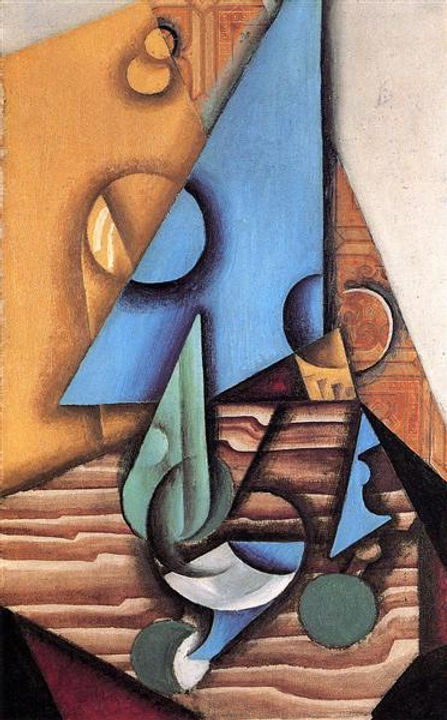
JUAN GRIS:
Bottle and Glass on a Table, 1914